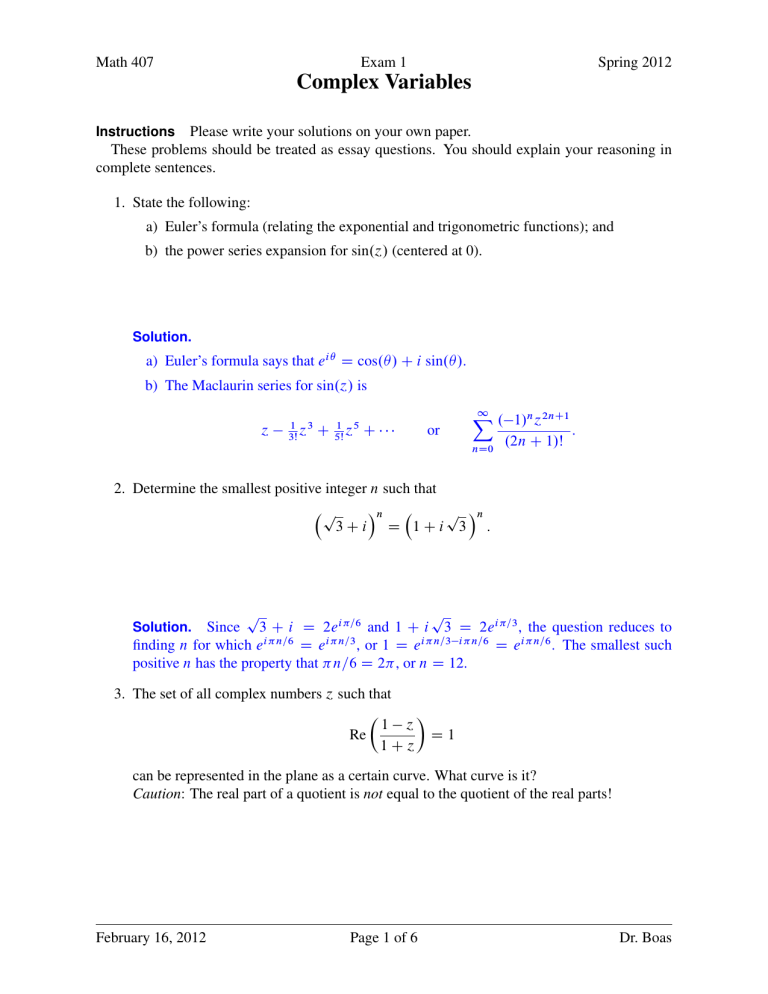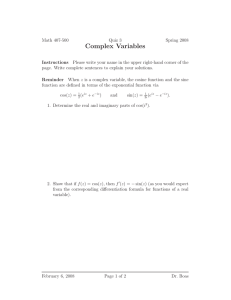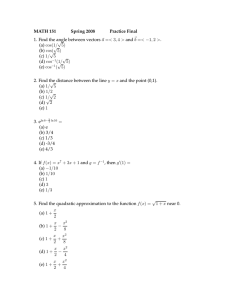Complex Variables
advertisement

Math 407 Exam 1 Spring 2012 Complex Variables Please write your solutions on your own paper. These problems should be treated as essay questions. You should explain your reasoning in complete sentences. Instructions 1. State the following: a) Euler’s formula (relating the exponential and trigonometric functions); and b) the power series expansion for sin.´/ (centered at 0). Solution. a) Euler’s formula says that e i D cos./ C i sin./. b) The Maclaurin series for sin.´/ is ´ 1 3 ´ 3Š C 1 5 ´ 5Š C or 1 X . 1/n ´2nC1 : .2n C 1/Š nD0 2. Determine the smallest positive integer n such that p n p n 3Ci D 1Ci 3 : p p Since 3 C i D 2e i =6 and 1 C i 3 D 2e i =3 , the question reduces to finding n for which e i n=6 D e i n=3 , or 1 D e i n=3 i n=6 D e i n=6 . The smallest such positive n has the property that n=6 D 2, or n D 12. Solution. 3. The set of all complex numbers ´ such that 1 ´ Re D1 1C´ can be represented in the plane as a certain curve. What curve is it? Caution: The real part of a quotient is not equal to the quotient of the real parts! February 16, 2012 Page 1 of 6 Dr. Boas Math 407 Exam 1 Spring 2012 Complex Variables Method 1 To find the real part of the quotient, start by multiplying both the numerator and the denominator by the complex conjugate of the denominator: Solution. 1 x iy 1 C x iy 1 x 2 y 2 2iy 1 ´ D D : 1C´ 1 C x C iy 1 C x iy .1 C x/2 C y 2 1 ´ 1 x2 y2 Therefore Re D . Setting this expression equal to 1 and clearing 1C´ .1 C x/2 C y 2 the denominator shows that 1 x2 y 2 D .1 C x/2 C y 2 : Simplifying yields that 0 D x C x 2 C y 2 , and completing the square shows that 14 D .x C 12 /2 C y 2 . This equation represents a circle of radius 12 centered at the point . 12 ; 0/. But the point . 1; 0/ is missing from the circle, because the original equation is undefined when ´ D 1. Method 2 A bit of algebraic trickery reduces the amount of calculation required. Since 1 C ´ 2´ 1 ´ D D1 1C´ 1C´ 2´ ; 1C´ 1 ´ ´ equals 1 precisely when the real part of equals 0. In other 1C´ 1C´ ´ words, the quantity is purely imaginary. An equivalent property, as long as ´ ¤ 1 1C´ 1C´ and ´ ¤ 0, is that the reciprocal is purely imaginary, or Re.1=´/ D 1. Now ´ the real part of x iy 1 D 2 ; ´ x C y2 so Re 1 x D 2 ; ´ x C y2 and setting this expression equal to 1 leads again to the condition that 0 D x C x 2 C y 2 , as obtained in Method 1. The case that ´ D 1 has to be excluded, as before. On the other hand, the special case that ´ D 0 evidently does satisfy the original equation. 4. Let f .´/ denote an analytic function with real part u.x; y/ and imaginary part v.x; y/. Determine f .´/ if @u D 3x 2 @x February 16, 2012 3y 2 and @v D 6xy C 1 @x Page 2 of 6 and f .0/ D 0: Dr. Boas Math 407 Exam 1 Spring 2012 Complex Variables Method 1 More information is given than is needed to solve the problem. Taking advantage of this extra information makes it possible to give a short solution. @v @u C i , the given information implies that Since f 0 D @x @x Solution. f 0 .x C iy/ D 3x 2 3y 2 C i.6xy C 1/: Then f 0 .x C i0/ D 3x 2 C i , so f 0 .´/ D 3´2 C i , and integrating shows that f .´/ D ´3 C i´ C C for some constant C . But f .0/ D 0, so C D 0. Therefore f .´/ D ´3 C i´. @v @u and are polynomials in x and y of degree 2, the @x @x @u @v function f .´/ must be a polynomial in ´ of degree 3. Moreover, since and have no @x @x first-degree terms, the function f .´/ must be missing its quadratic term. And the constant term in f .´/ is missing too, since f .0/ D 0. Accordingly, Method 2 Since the derivatives f .x C iy/ D .a3 C ib3 /.x C iy/3 C .a1 C ib1 /.x C iy/ D a3 x 3 3b3 x 2 y 3a3 xy 2 C b3 y 3 C a1 x C i.b3 x 3 C 3a3 x 2 y 3b3 xy 2 b1 y a3 y 3 C a1 y C b1 x/; where a3 , b3 , a1 , and b1 are real constants to be determined. Then @u D 3a3 x 2 @x 6b3 xy 3a3 y 2 C a1 ; @u shows that a3 D 1, b3 D 0, and a1 D 0. so comparing with the given expression for @x Similarly, @v D 3b3 x 2 C 6a3 xy 3b3 y 2 C b1 ; @x @v and comparing with the given expression for confirms that b3 D 0 and a3 D 1 and @x shows that b1 D 1. Therefore f .´/ D ´3 C i´. Method 3 Integrating the first equation with respect to x shows that u.x; y/ D x 3 3xy 2 C C.y/, where C.y/ is a function of y to be determined. Then @u D @y 6xy C C 0 .y/: @u @v D by the Cauchy–Riemann equations, so comparing with the second given @y @x equation shows that C 0 .y/ D 1, or C.y/ D y Cb for some constant b to be determined. In other words, u.x; y/ D x 3 3xy 2 y Cb. The given information that f .0/ D 0 implies that u.0; 0/ D 0 D v.0; 0/, so b D 0 and u.x; y/ D x 3 3xy 2 y. But February 16, 2012 Page 3 of 6 Dr. Boas Math 407 Exam 1 Spring 2012 Complex Variables @v D 6xy C1, integrating with respect to x shows that v.x; y/ D 3x 2 y C @x x C A.y/ for a function A.y/ to be determined. Then Similarly, since @v D 3x 2 C A0 .y/: @y @v @u D by the Cauchy–Riemann equations, so comparing with the first given equa@y @x tion shows that A0 .y/ D 3y 2 , or A.y/ D y 3 (the integration constant is 0 as before, since v.0; 0/ D 0). Thus v.x; y/ D 3x 2 y C x y 3 . But Putting the above deductions together shows that f .x C iy/ D u.x; y/ C iv.x; y/ D x 3 3xy 2 y C i.3x 2 y C x y 3 /. In particular, f .x C i0/ D x 3 C ix. Since f .´/ evidently is a polynomial in ´, it follows that f .´/ D ´3 C i´. 5. Evaluate the limit lim .cos ´/1=´ 2 ´!0 (using the principal branch of the logarithm). 2 By definition, .cos ´/1=´ D exp ´12 log cos ´ , and the exponential function is continuous, so what needs to be computed is log cos ´ : exp lim ´!0 ´2 Solution. Method 1 Since cos.0/ D 1, and the principal branch of log.1/ equals 0, l’Hôpital’s rule can be invoked to say that log cos ´ D lim ´!0 ´!0 ´2 lim sin.´/= cos.´/ : 2´ sin.´/ D ´!0 ´ Now either apply l’Hôpital’s rule a second time or use the known result that lim 1 to conclude that 1 : 2 sin.´/= cos.´/ D 2´ lim ´!0 Accordingly, the answer to the original problem is e 1=2 . Method 2 Use series expansions to say that log.1 log cos ´ D 2 ´ February 16, 2012 1 2 ´ C 2 ´2 O.´4 // D Page 4 of 6 1 2 ´ 2 C O.´4 / D ´2 1 2 C O.´2 /; Dr. Boas Math 407 Exam 1 Spring 2012 Complex Variables where the symbol O.´k / stands for terms of order ´k or higher. Therefore log cos ´ D ´!0 ´2 lim and the answer to the original problem is e 1=2 1 ; 2 . 6. The hyperbolic tangent function, tanh, can be defined as follows: tanh.´/ D e´ e e´ C e ´ ´ : For which values of the complex variable ´ is tanh.´/ not analytic? In other words, what are the singular points of the hyperbolic tangent function? There are singular points where the denominator is equal to 0. Now e ´ Ce 0 if and only if e ´ D e ´ , or e 2´ D 1. Since 1 D e iC2n i , it follows that Solution. ´ D 2´ D i C 2n i for an arbitrary integer n, so ´ D 21 i C n i for an arbitrary integer n. Extra credit Creatures from the galaxy Mocplex say that a function u.x; y/ is morhanic if @u @u C D 0: @x @y Are there any nonconstant analytic functions that have morhanic real part? Yes. If f .´/ D .1 C i/a´ C c C id (where a, c, and d are real constants), then f is analytic, and the real part u.x; y/ equals ax ay C c; evidently Solution. @u @u C Da @x @y a D 0; so u is morhanic. February 16, 2012 Page 5 of 6 Dr. Boas Math 407 Exam 1 Spring 2012 Complex Variables The indicated form for f is the most general possible. To see why, observe that if u is morhanic, then differentiating the defining property first with respect to x and then with respect to y shows that @2 u @2 u @2 u @2 u C D 0 and C D 0: @x 2 @x@y @y@x @y 2 Consequently, @2 u @2 u D D @x 2 @y 2 @2 u : @x@y @2 u @2 u But also 2 C 2 D 0, since the real part of an analytic function is harmonic, so the preceding @x @y equation implies that all second-order partial derivatives of u are identically equal to 0. Therefore u.x; y/ must be a polynomial in x and y of degree at most 1: namely, u.x; y/ D ax C by C c for certain real constants a, b, and c. Since u is morhanic, b must equal a. Now x D Re.´/ and y D Re.i´/, so u.x; y/ D Re.a´ C ai´ C c/. Therefore f .´/ D .1 C i/a´ C c plus an arbitrary imaginary constant. February 16, 2012 Page 6 of 6 Dr. Boas




